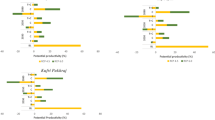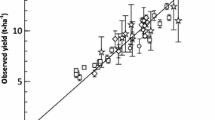Abstract
Understanding the impacts of climate change on agriculture is essential to ensure adequate future food production. Controlled growth experiments provide an effective tool for assessing the complex effects of climate change. However, a review of the use of climate projections in 57 previously published controlled growth studies found that none considered within-season variations in projected future temperature change, and few considered regional differences in future warming. A fixed, often arbitrary, temperature perturbation typically was applied for the entire growing season. This study investigates the utility of employing more complex climate change scenarios in growth chamber experiments. A case study in potato was performed using three dynamically downscaled climate change projections for the mid-twenty-first century that differ in terms of the timing during the growing season of the largest projected temperature changes. The climate projections were used in growth chamber experiments for four elite potato cultivars commonly planted in Michigan’s major potato growing region. The choice of climate projection had a significant influence on the sign and magnitude of the projected changes in aboveground biomass and total tuber count, whereas all projections suggested an increase in total tuber weight and a decrease in specific gravity, a key market quality trait for potato, by mid-century. These results demonstrate that the use of more complex climate projections that extend beyond a simple incremental change can provide additional insights into the future impacts of climate change on crop production and the accompanying uncertainty.





Similar content being viewed by others
References
Andresen JA, Hilberg SD, Kunkel KE (2013) Historical climate and climate trends in the Midwestern United States. In: Winkler JA, Andresen JL, Hatfield J, Bidwell D, Brown D (eds) Climate change in the Midwest: a synthesis report for the National Climate Assessment. Island Press, Washington, D.C., pp 8–36
Basile SJ, Rauscher SA, Steiner AL (2017) Projected precipitation changes within the Great Lakes and western Lake Erie Basin: a multi-model analysis of intensity and seasonality. Int J Climatol 37(14):4864–4879. https://doi.org/10.1002/joc.5128
Bassu S, Brisson N, Duran J-L et al (2014) How do various maize crop models vary in their response to climate change factors? Glob Chang Biol 20(7):2301–2320. https://doi.org/10.1111/gcb.12520
Caldwell CR, Britz SJ, Mirecki RM (2005) Effect of temperature, elevated carbon dioxide, and drought during seed development on the isoflavone content of dwarf soybean [Glycine max (L.) Merrill] grown in controlled environments. J Agr Food Chem 53(4):1125–1129. https://doi.org/10.1021/jf0355351
Cheng W, Sakai H, Yagi K, Hasegawa T (2009) Interactions of elevated [CO2] and night temperature on rice growth and yield. Agric For Meteorol 149(1):51–58. https://doi.org/10.1016/j.agrformet.2008.07.006
Collins M, Knutti R, Arblaster J, Dufresne J-L et al (2013) Long-term climate change: projections, commitments and irreversibility. In: Stocker TF, Qin D, Plattner G-K, Tignor M, Allen SK, Boschung J, Nauels A, Xia Y, Bex V, Midgley PM (eds) Climate change 2013: the physical science basis. Contribution of Working Group I to the Fifth Assessment Report of the Intergovernmental Panel on Climate Change. Cambridge University Press, Cambridge, United Kingdom and New York, NY, USA, pp 1029–1138
Conn JS, Cochran VL (2006) Response of potato (Solanum tuberosum L.) to elevated atmospheric CO2 in the North American subarctic. Agric Ecosyst Environ 112(1):49–57. https://doi.org/10.1016/j.agee.2005.07.010
Craigon J, Fangmeier A, Jones M, Donnelly A, Bindi M, De Temmerman L, Persson K, Ojanpera K (2002) Growth and marketable-yield responses of potato to increased CO2 and ozone. Eur J Agron 17(4):273–289. https://doi.org/10.1016/S1161-0301(02)00066-7
Drake BG, Gonzalez-Meler MA, Long SP (1997) More efficient plants: a consequence of rising atmospheric CO2. Ann Rev Plant Physiol Plant Mol Biol 48(1):609–639. https://doi.org/10.1146/annurev.arplant.48.1.609
Fleisher DH, Condori B, Quiroz R, Alva A, Asseng S, Barreda C, Bindi M, Boote KJ, Ferrise R, Franke AC, Govindakrishnan PM, Harahagazwe D, Hoogenboom G, Naresh Kumar S, Merante P, Nendel C, Olesen JE, Parker PS, Raes D, Raymundo R, Ruane AC, Stockle C, Supit I, Vanuytrecht E, Wolf J, Woli P (2017) A potato model intercomparison across varying climates and productivity levels. Glob Chang Biol 23(3):1258–1281. https://doi.org/10.1111/gcb.13411
Gibson LR, Paulsen GM (1999) Yield components of wheat grown under high temperature stress during reproductive growth. Crop Sci 39(6):1841–1846. https://doi.org/10.2135/cropsci1999.3961841x
Hayhoe K, VanDorn J, Croley T II, Schlegal N, Wuebbles D (2010) Regional climate change projections for Chicago and the US Great Lakes. J Great Lakes Res 36:7–21. https://doi.org/10.1016/j.jglr.2010.03.012
Högy P, Fangmeier A (2009a) Atmospheric CO2 enrichment affects potatoes: 1. aboveground biomass production and tuber yield. Europ J Agron 30(2):78–84. https://doi.org/10.1016/j.eja.2008.07.007
Högy P, Fangmeier A (2009b) Atmospheric CO2 enrichment affects potatoes: 2. tuber quality traits. Europ J Agron 30(2):85–94. https://doi.org/10.1016/j.eja.2008.07.006
Jablonski LM, Wang X, Curtis PS (2002) Plant reproduction under elevated CO2 conditions: a meta-analysis of reports on 79 crops and wild species. New Phytol 156(1):9–26. https://doi.org/10.1046/j.1469-8137.2002.00494.x
Lawlor DW, Mitchell RAC (1991) The effect of increasing CO2 on crop photosynthesis and productivity: a review of field studies. Plant Cell Environ 14(8):807–818. https://doi.org/10.1111/j.1365-3040.1991.tb01444.x
Love SL (1999) Founding clones, major contributing ancestors, and exotic progenitors of prominent North American potato cultivars. Amer J of Potato Res 76(5):263–272. https://doi.org/10.1007/BF02853624
Lulai ED, Orr PH (1979) Influence of potato specific gravity on yield and oil content of chips. Am Potato J 56(8):379–390. https://doi.org/10.1007/BF02855348
Mearns LO, Arritt R, Biner S, Bukovsky MS, McGinnis S, Sain S, Caya D, Correia J Jr, Flory D, Gutowski W, Takle ES, Jones R, Leung R, Moufouma-Okia W, McDaniel L, Nunes AMB, Roads J, Sloan L, Snyder M (2012) The North American Regional Climate Change Program: overview of phase I results. B Am Meteorol Soc 93(9):1337–1362. https://doi.org/10.1175/BAMS-D-11-00223.1
Michigan Department of Agriculture and Rural Development (MDARD) (2017) www.michigan.gov/mdard. Accessed 2 August 2017
Nakićenović NJ et al (2000) Special report on emissions scenarios: a special report of Working Group III of the Intergovernmental Panel on Climate Change. Cambridge University Press, Cambridge, U.K.
Nowak RS, Ellsworth DS, Smith SD (2004) Functional responses of plants to elevated atmospheric CO2—do photosynthestic and productivity data from FACE experiments support early predictions? New Phytol 162:252–280
Qaderi MM, Kurepin LV, Reid DM (2006) Growth and physiological responses of canola (Brassica napus) to three components of global climate change: temperature, carbon dioxide and drought. Physiol Plantarum 128(4):710–721. https://doi.org/10.1111/j.1399-3054.2006.00804.x
Peiris DR, Crawford JW, Grashoff C, Jefferies RA, Porter JR, Marshall B (1996) A simulation study of crop growth and development under climate change. Agric For Meteorol 79(4):271–287. https://doi.org/10.1016/0168-1923(95)02286-4
Prasad PVV, Boote KJ, Allen LH Jr, Thomas JMG (2003) Super-optimal temperatures are detrimental to peanut (Arachis hypogaea L.) reproductive processes and yield at both ambient and elevated carbon dioxide. Glob Chang Biol 9(12):1775–1787. https://doi.org/10.1046/j.1365-2486.2003.00708.x
R Core Team (2015) R: a language and environment for statistical computing. R Foundation for Statistical Computing, Vienna. https://www.R-project.org/. Accessed 2 August 2017
Reddy KR, Hodges HF, McKinion JM (1997) A comparison of scenarios for the effect of global climate change on cotton growth and yield. Aus J Plant Physiol 24(6):707. https://doi.org/10.1071/PP96138
Rodrigues WP, Martins MQ, Fortunato AS, Rodrigues AP, Semedo JN, Simões-Costa MC, Pais IP, Leitão AE, Colwell F, Goulao L, Máguas C, Maia R, Partelli FL, Campostrini E, Scotti-Campos P, Ribeiro-Barros AI, Lidon FC, DaMatta FM, Ramalho JC (2016) Long-term elevated air [CO2] strengthens photosynthetic functioning and mitigates the impact of supra-optimal temperatures in tropical Coffea arabica and C. canephora species. Glob Chang Biol 22(1):415–431. https://doi.org/10.1111/gcb.13088
Rosenzweig C, Parry M (1994) Potential impact of climate change on world food supply. Nature 367(6459):133–138. https://doi.org/10.1038/367133a0
Timlin D, Rahman SML, Baker J, Reddy VR, Fleisher D, Quebedeaux B (2006) Whole plant photosynthesis, development, and carbon partitioning in potato as a function of temperature. Agron J 98(5):1195–1203. https://doi.org/10.2134/agronj2005.0260
Tubiello FN, Ewert F (2002) Simulating the effects of elevated CO2 on crops: approaches and applications for climate change. Europ J Agronomy 18(1-2):57–74. https://doi.org/10.1016/S1161-0301(02)00097-7
Van Dam J, Koom PL, Struik PC (1996) Effects of temperature and photoperiod on early growth and final numbers of tubers in potato (Solanum tuberosum L.) Potato Res 39:51–62
Vu JCV, Gesch RW, Pennanen AH, Hartwell LA Jr, Boote KJ, Bowes G (2001) Soybean photosynthesis, Rubisco, and carbohydrate enzymes function at supraoptimal temperatures in elevated CO2. J Plant Physiol 158:295–307
Winkler JA, Arritt RW, Pryor SC (2014) Climate projections for the Midwest: availability, interpretation, and synthesis. In: Winkler JA, Andresen JA, Hatfield JL, Bidwell D, Brown D (eds) Climate change in the Midwest: a synthesis report for the National Climate Assessment. Island Press, Washington, D.D, pp 37–69
Winkler JA, Guentchev GS, Perdinan, Tan P-N, Zhong S, Liszewska M, Abraham Z, Niedźwiedź T, Ustrnul Z (2011) Climate scenario development and applications for local/regional climate change impact assessments: an overview for the non-climate scientist. Part I: scenario development using downscaling methods. Geogr Compass 5(6):275–300. https://doi.org/10.1111/j.1749-8198.2011.00425.x
Yoon ST, Hoogenboom G, Flitcroft I, Bannayan M (2009) Growth and development of cotton (Gossypium hirsutum L.) in response to CO2 enrichment under two different temperature regimes. Environ Exp Bot 67(1):178–187. https://doi.org/10.1016/j.envexpbot.2009.06.015
Zhou X, Ge Z-M, Kellomaki S, Wang K-Y, Peltola H, Martikainen P (2011) Effects of elevated CO2 and temperature on leaf characteristics, photosynthesis and carbon storage in aboveground biomass of a boreal bioenergy crop (Phalaris arundinacea L.) under varying water regimes. GCB Bioenergy 3(3):223–234. https://doi.org/10.1111/j.1757-1707.2010.01075.x
Acknowledgements
We would like to acknowledge Megan Conway and Paul Rosemurgy for their help with tuber harvesting. We also thank Chris Long for helpful discussions about potato growing conditions and harvest. We thank the North American Regional Climate Change Assessment Program for providing the regional climate model simulations.
Funding
This project was supported by Michigan State University GREEEN Proposal #GR15-008. The climate projections used in the study were developed with support from the National Science Foundation (Award CNH 0909378). Any opinions, findings, conclusions, or recommendations expressed in this material are those of the authors and do not reflect the views and policies of the funding agencies.
Author information
Authors and Affiliations
Corresponding author
Rights and permissions
About this article
Cite this article
Leisner, C.P., Wood, J.C., Vaillancourt, B. et al. Impact of choice of future climate change projection on growth chamber experimental outcomes: a preliminary study in potato. Int J Biometeorol 62, 669–679 (2018). https://doi.org/10.1007/s00484-017-1475-1
Received:
Revised:
Accepted:
Published:
Issue Date:
DOI: https://doi.org/10.1007/s00484-017-1475-1




